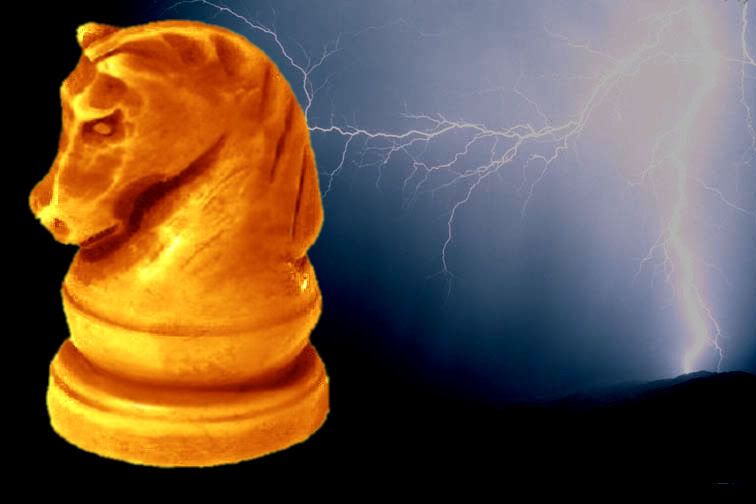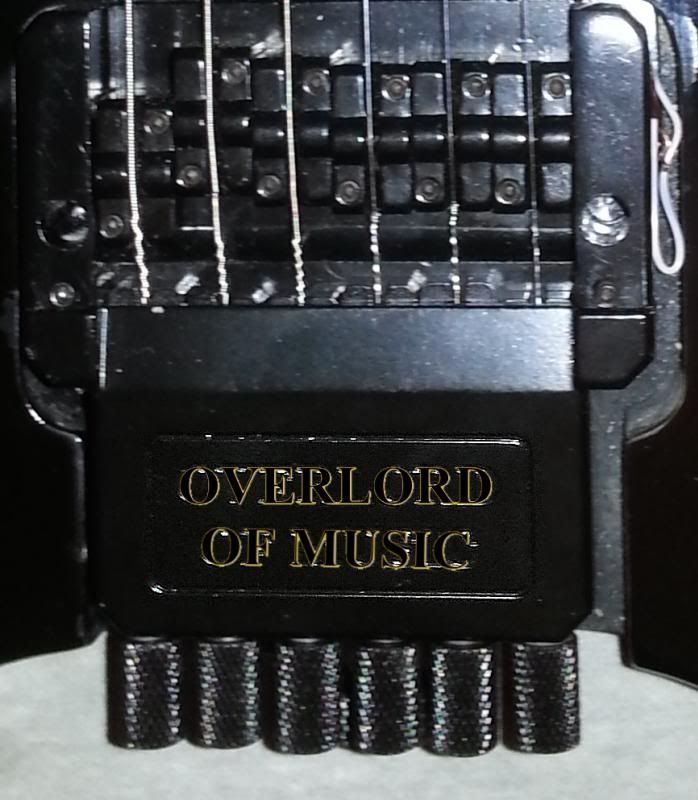Post by Runewalker on Mar 10, 2014 17:50:04 GMT -5
I debated on putting this in the "Truely Nutzoid" Section. But after looking at some of the designs, and noting that the simple Pup Selector Map documents at least 30 combos, I decided ... what the hay. If OoP were added, which could be done, then the multipliers rocket the possible number of combos. Besides, it was maybe 90% as difficult to wire up as the HBD, which is in this section.... I mean, check out the spaghetti bowl in the wiring design....
HH3 (HH cubed)
HH: 2 Vol. 2 Tone.
Local Parallel/Single/Series and System Parallel/Series
AKD: the OverLord of Music (see threads that follow) OM
The 1st subtitle emphasizes a key feature of this design:
A DPDT on-on-on Switch selects one of Local Parallel/Single/Series options for each humbucker in an HH configuration --- 3 Local settings for each Humbucker. That 3 way option suggests the name of the Design: HH3, or HH Cubed, or 2H3, etc.
A cascade of options are subsequently available in the Neck/Bridge pickups’ combos.
The other key feature in the design is a System Series switch that, when engaged, irrespective of where the Pickup selector is, places the Neck and Bridge pickups in System Series. I presume an OoP switch could be added but in the Single/Single combo you would get AC hum. It would work fine in the humbucker combinations. I had no room in the specific installation for an OoP switch.
(I know engineer/mathematic types will quibble on whether the H times H times H is really manifest here as a power of 3 equation, and of course you are right. Allow a little artistic license opposed to a precise formula here. You could claim that with the variable tone capabilities available with mixing the levels of each pup when in Neck/Bridge combos you get logarithmic level tone variables, but indulge me as I try not to overthink it.)
Schematic
If this is preferred I will have to beg for help.
Credit
As usual with design ideas I have proposed, John [Led]Hewitt, has come to my rescue. I went down the path of trying the wiring layout and it was pathetically wrong. John set me straight and gave me a draft. As always, thank you John.
The wiring Diagram:
John asked that I notate that the pickup wire colors are Seymour Duncan referenced, but the start/finish and polarity of the wires are labeled as well.
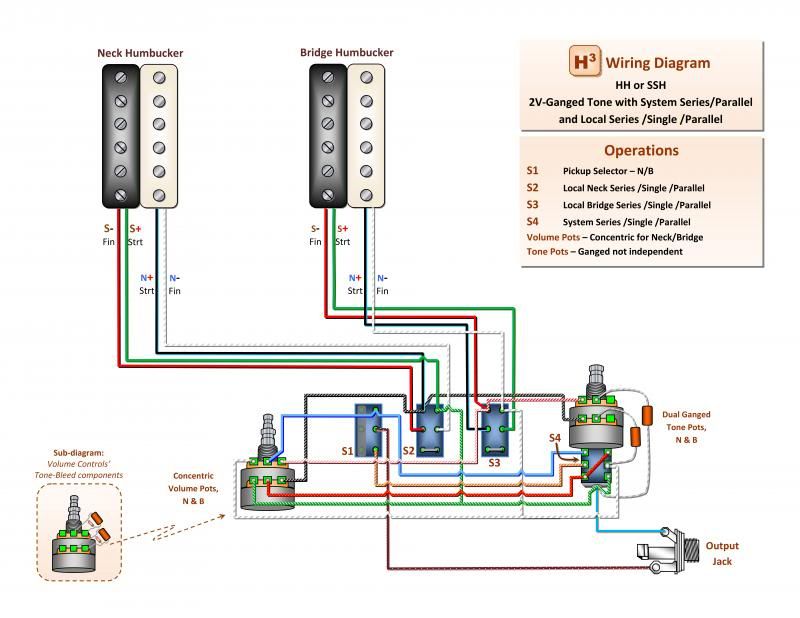
Pickup Selection Map

Local Parallel/Single/Series Humbucker switching is a familiar option that is documented on many sites for years, for example Seymore Duncan and Guitar Electronics. Here is a link to a Guitar Electronics design post that is similar but it requires that the Pickup selector be in the Neck Position to access system Parallel/Series.:
Guitar Electronics version
This design sprang from one of my first Mods. It was Mod conducted before I found the folks on this knowledgeable and generous Forum. I pieced together a modular wiring scheme from different places on the web (the link above was unavailable at the time). It worked but the OoP part of the scheme was extremely noisy, and I did not know enough to ensure that System Single arrays were humcancelling. I discovered later through discussions here why the OoP had those problems
It was time to re-do it. The design discussion is here:
A hopefully small request: HH-design
The discussion in the thread gets pretty random (not that tangential thinking ever occurs in this forum...), but it finally resolves to the design. Eventually the first application I used this design it on was not one of my HHs in the work-stream. Instead it is built into a travel guitar. That chassis had a very small cavity and minor alterations had to be instated.
Here is a picture of the cavity stuffed to the gills. I believed I tested the limits of how many options could be shoved into a small space. .
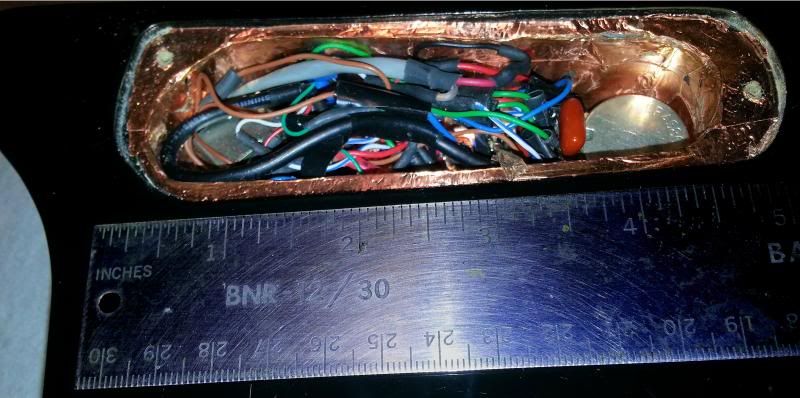
The ruler does not show up well in the pix, but the plate cover is about 5 inches and the actual cavity is about 4.25" by maybe an inch and a quarter. Really tight to shove all that stuff in and took some dremel work in the cavity.
I say "believe" above because I am relatively certain that the Nutz could find more stuff to do. Trust me though there is no more room for another DPDT switch and a 4PDT will not fit... (Now if I could find a concentric pot with a DPDT .... Yes I know there are some from Europe - MEC duplos. The ones that are 500K are exceeding hard to find and whoo boy get ready to fork it over. Wtih shipping that one switch/pot combo would cost half again as much as I paid for the entire chassis. Violates design principles. Eventually switches have to be replaced, and then good luck finding it again.)
What is the conceptual design?
- Each humbucker has a mini-DPDT On-On-On switch to give Local Parallel/Single (cut coil)/Series
- There is a simple Gibson style Neck/Both/Bridge Pickup Selector. In this case because of the small space I used another DPDT on-on-on switch with a paddle handle to differentiate it from the ones with the bat handles.
- There is a System Parallel/Series switch. I used an unusual dual ganged (non-concentric) with a Push/Pull DPDT switch for this build [very cool component].
In the travel guitar I had to opt for a ganged dual pot for the Tone Controls because of tight cavity real-estate.
[li]Finally there is a Volume control for each pup. (again due to space issues, I used a dual ganged concentric pot.) Depending on control cavity space there are separate Tone controls for each pup.[/li]
[/ul]
Below is the (nearly) finished chassis. The middle position DPDT, which is the Neck on-on-on had a little operator error slippage on the drilling and is subsequently not well centered. I planned on a small plate to cover the slot anyway and will fix alignment then. Also we want to dial in the frets a little better, but the action is not really anything to complain about. The pups are Duncan Designed versions of his JB/Jazz set. We have A/B-ed them aganist the USA versions and can not hear a difference, although you will hear others hew and cry about the 'cR_p that comes from the east. Same winding machines, same materials, same sound. works for me. $40 a set on Ebay instead of $140-$150? Works for me. - I have maybe $190 in this "thang." .... K-K-K-K-Tone!
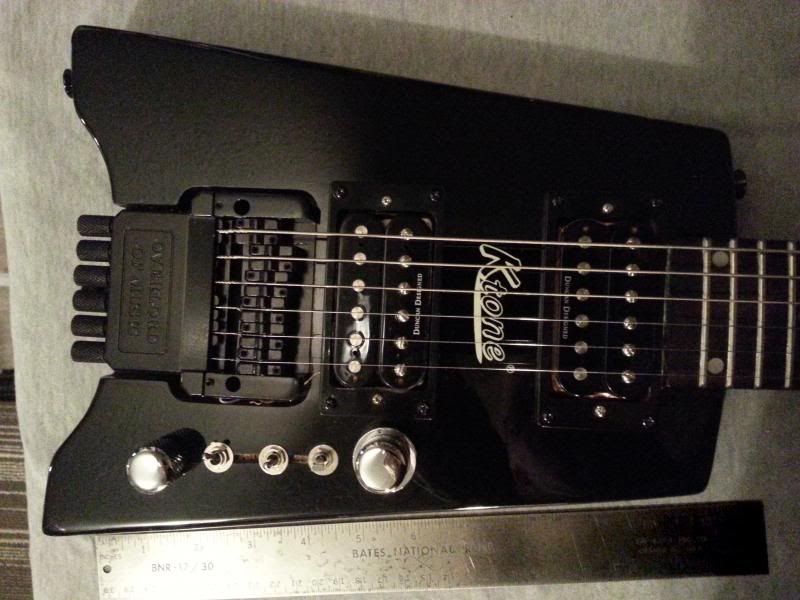
Discussion
As I note this design notion has been around a while, so I don't claim to be plowing new ground here. It was the first one I ever tried to wire up back around 2005.
Pretty straightforward, but also very flexible. The independent Volume controls are important to me because in combo positions, control the mix of the Neck or Bridge volume pots acts as very effective Tone controls. I like that feature especially because conventional tone controls sound muffled to me. Controlling the mix of the pups allows a more full range adjustment of tone – at least to my ears.
I arrayed the Humbucker positions so that the inner coils are selected in cut coil mode. Certainly you could do it outer/outer for the Tele simulation --- personal preference. With inner/inner combos you [should] get fair to good quack in System Parallel, especially in a 24 fret guitar (where the pups are closer together – emulating the Strat spacing geometry of the Neck/Mid in parallel). In System Series the two singles emulate a Les Paul Custom middle position humbucker in its three humbucker configuration, with additional adjustments conveyed from the volume mix. The System Series switch adds some beef when required.
Two nice features are the way John set up the switching logic so that:
1. Regardless of whether the pup selector is located (neck/both/bridge), when the System Series switch is engaged both pups are auto-selected.
This allows easy adjustments during a song with one movement. For example, if you are in the Neck Single or Neck Local Parallel for a rhythm passage, a simple engagement of the System Series switch will kick in the Bridge/Neck combo in series. You can preset the Bridge into one of the Local Parallel/Single/Series for a bit of wind behind your back or a full gale force with the Bridge Local Series/Neck Selection/System Series combo.
2. The Neck and Bridge Single/Single combos are hum-cancelling.
You can arrange the physical orientation of the pups to Inner/Inner, Outer/Outer, Inner/Outer or Outer/Inner to reflect the tonalities you wish to emphasize.
I selected the Inner/Inner location under the theory that in a 24 fret guitar, which the travel guitar has, that there would be a higher likelihood of obtaining Strat “Quack”, with the spacing more similar to Strat Neck/Mid dimensions. Nice theory, but I do not get a great deal of hearable Quack in the travel guitar. May be the pups. May be the theory. I also wanted the Bridge single in the Inner position to avoid too much “ice pick” treble. That worked nicely as the Neck single on these pups is quite musical.
You could select Outer/Outer for more of a theoretical Tele Sound.
This allows easy adjustments during a song with one movement. For example, if you are in the Neck Single or Neck Local Parallel for a rhythm passage, a simple engagement of the System Series switch will kick in the Bridge/Neck combo in series. You can preset the Bridge into one of the Local Parallel/Single/Series for a bit of wind behind your back or a full gale force with the Bridge Local Series/Neck Selection/System Series combo.
2. The Neck and Bridge Single/Single combos are hum-cancelling.
You can arrange the physical orientation of the pups to Inner/Inner, Outer/Outer, Inner/Outer or Outer/Inner to reflect the tonalities you wish to emphasize.
I selected the Inner/Inner location under the theory that in a 24 fret guitar, which the travel guitar has, that there would be a higher likelihood of obtaining Strat “Quack”, with the spacing more similar to Strat Neck/Mid dimensions. Nice theory, but I do not get a great deal of hearable Quack in the travel guitar. May be the pups. May be the theory. I also wanted the Bridge single in the Inner position to avoid too much “ice pick” treble. That worked nicely as the Neck single on these pups is quite musical.
You could select Outer/Outer for more of a theoretical Tele Sound.
Again, space constraints prevented adding an OoP in this application, which I was fine with. However, unexpectedly I miss OoP capability in this build. If I could mix in just a tad of OoP I could achieve a more similar Strat sound. In single modes these pups do sound good, but would not be confused for a Strat. Oh well.
I may beg John to help with a variant with OoP. The original thread that developed this references a Franken-Iby-ESP that was the intended victim and it is already drilled for the OoP switch.
If this works for you, then please enjoy.
Thank you again John. His name should be on this, not mine.
RW


